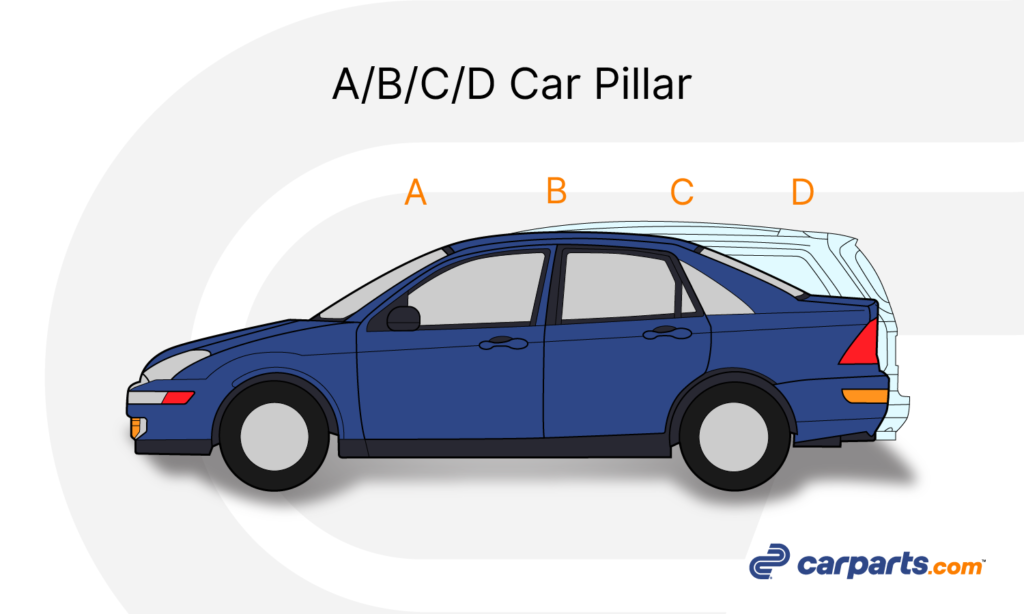The vertical support that provides structural integrity to a vehicle’s roof is called a roof pillar. Most cars have three different pillars, but station wagons, minivans, and SUVs usually have at least four. Each pillar is assigned a letter from A to D to indicate where it is on the vehicle.
Where Are the Different Pillars Located?
Pillars A, B, and C are sometimes referred to as the front, center, and rear pillars. However, this only applies to sedans, as station wagons, minivans, and SUVs have extended cargo areas with support structures called D pillars. This naming convention is used by manufacturers to identify roof pillars from the side.

A Pillar
The A pillar is the support structure that holds the windshield in place. It’s located in the front of the vehicle. The pillar’s location is the same for sedans, station wagons, minivans, and SUVs.
B Pillar
The B pillar is the support structure in the center of the vehicle. It’s located between the A pillar and the C pillar. Limousines can have more than one B pillar (B1, B2, and so on).
C Pillar
The C Pillar is the support structure located on either side of a sedan’s rear window. The pillar’s location is different for station wagons, minivans, and SUVs. Rather than being the structure holding the rear window in place, the C pillar, in this case, describes the vertical structure behind the rear door.
D Pillar
The D pillar replaces the C pillar as the rearmost support structure on station wagons, minivans, and SUVs. It corresponds with the C pillar located behind the rear door.

Why Do You Need to Know the Difference Between Pillars?
Knowing the difference between roof pillars is important because manufacturers use them in their specifications. Some cars have thicker pillars that can limit your road visibility. A reviewer might say that a vehicle’s A pillar is wide. That means the front roof pillars are wide enough to create a blind spot. Many classic cars have slimmer A pillars that provide better visibility at the cost of structural stability and strength. Convertibles don’t usually have B pillars behind their front doors, which leaves a gap when the doors are opened.
To cut it short, make sure to consider a vehicle’s roof pillars when window shopping because they can affect your vision on the road.
When to Replace the A, B, C, and D Pillars of a Car
It’s a good practice to replace the A, B, C, and D pillars of any vehicle when there are visible signs of damage. Keep an eye out for rust and corrosion, damage and deformations, and misalignment.
Rust and Corrosion
It’s best to replace car pillars once they start showing signs of rust and corrosion, typically due to the elements, too much road salt exposure, neglect, and/or poor maintenance. They can damage the integrity of the pillars, making them weaker.
Rusty pillars are no joke, as they’re more likely to crumble or collapse during high-impact collisions. If you see corroded spots in your vehicle’s pillars, consider having it checked by a mechanic as soon as possible.
Damage and Deformations
Pillars are just as susceptible to damage from collision accidents as any other part of the vehicle. If you get into an accident and any of the pillars of your vehicle bend or sustain dents in any way, don’t disregard them.
Dents, cracks, and other forms of damage can compromise the pillars’ structural integrity. As a result, they won’t be able to serve as the vehicle’s foundations safely and effectively.
However, note that accidents aren’t the only thing that can damage the pillars. Time can take its toll as well. An unfortunate reality of any auto part is that the longer it lasts, the more likely it is to degrade and deform over time. Car pillars are no exception.
Though it takes a long time, auto parts can crack or bend out of shape even if they’re properly maintained.

Misalignment
If you notice that the doors and windows of your vehicle don’t line up properly, there might be something wrong with the pillars. If this happens, it’s a good idea to inspect the pillars closely or have an expert weigh in their opinion.
If the pillars don’t line up, it might be time to replace them. It’s a necessity that ensures the vehicle meets modern safety standards.
Where to Get Replacement Pillars for Your Ride
Looking to replace the pillars in your vehicle? Look no further than CarParts.com. Whether you need new A pillars, B pillars, or any other pillar components, we have you covered.
We offer a wide selection of replacement pillar panels for various makes and models, so you’re sure to find one for your ride. Simply input your ride’s details into our user-friendly search tool to find the parts you need.
Products in our catalog are handpicked by our team of industry veterans, ensuring durability and structural integrity. Plus, we have nationwide distribution centers to ensure fast and efficient shipping.
All our replacement parts come with a low-price guarantee. You don’t have to go over your budget just to get top-notch replacement parts for your ride.
Explore our selection of replacement pillars, and place your order today!
Any information provided on this Website is for informational purposes only and is not intended to replace consultation with a professional mechanic. The accuracy and timeliness of the information may change from the time of publication.

















